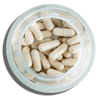Licorice root, derived from the Glycyrrhiza glabra plant, has been used for thousands of years to support respiratory health. Modern research confirms its antiviral, anti-inflammatory, and immune-boosting properties, making it effective against colds, flu, and even severe viruses like SARS-CoV-2. Its key active compound, glycyrrhizin, disrupts viral replication, reduces inflammation, and enhances immune response. However, improper use can lead to serious side effects, so safe consumption is essential.
Key Benefits of Licorice Root:
- Antiviral Effects: Blocks virus replication and spread.
- Anti-Inflammatory: Reduces throat and lung inflammation.
- Immune Support: Boosts interferon production to fight infections.
- Clinical Evidence: Shortens hospital stays for respiratory illnesses like COVID-19 and influenza.
Safe Usage Tips:
- Limit glycyrrhizin intake to 100 mg/day.
- Use forms like dried root powder (1–5 g) or extracts (250–300 mg) short-term.
- Avoid if you have heart, kidney, or blood pressure issues, or are pregnant.
Licorice root offers a natural way to support respiratory health, but always consult a healthcare provider before use to avoid risks.
Merlion Naturals Liquorice Root Powder | Benefits of Liquorice Root Powder | मुलेठी पाउडर के फायदे

Active Compounds in Licorice Root
Licorice root has a long history of medicinal use, and its wide array of compounds plays a key role in its modern applications, particularly in supporting respiratory health and fighting viral infections. It contains nearly 300 flavonoids and over 20 triterpenoids, all of which contribute to its health benefits [3].
These compounds work together, creating stronger effects than any single compound could achieve on its own. Below, we’ll explore some of the key compounds and how they function.
Glycyrrhizin: The Star Compound
Glycyrrhizin (or glycyrrhizic acid) is the standout compound in licorice root. Known for its antiviral, anti-inflammatory, and antimicrobial properties, glycyrrhizin is a major contributor to licorice root's health benefits [2][5]. High-quality wild licorice can contain up to 7% glycyrrhizin by weight [7].
Once consumed, glycyrrhizin is metabolized into 18β-glycyrrhetinic acid, which significantly boosts its effectiveness. In fact, glycyrrhetinic acid has been found to be 7.5 times more effective against the Epstein–Barr virus compared to glycyrrhizin [7]. This compound not only disrupts viral replication but also helps regulate immune responses, reducing the risk of harmful inflammation.
Other Key Compounds and Their Benefits
Licorice root’s benefits extend beyond glycyrrhizin, thanks to several other powerful compounds. These include liquiritigenin (LTG), licochalcone A (LCA), licochalcone E (LCE), and glabridin (GLD) [3]. Together, these compounds enhance licorice root’s anti-inflammatory, antimicrobial, and antiviral properties [3].
- Liquiritigenin and licochalcones: These compounds strengthen licorice root’s ability to fight inflammation and infections.
- Glabridin: Adds to the antiviral effects, further boosting the root’s therapeutic potential.
Interestingly, the method used to extract licorice compounds can influence their effectiveness. For example:
- Methanol extracts show strong activity against hepatitis C.
- Alkaline extracts are particularly effective against HIV.
- Ethanol extracts help reduce RANTES secretion in H1N1-infected cells [4].
The combined action of these compounds explains why whole licorice root extracts often deliver better results than isolated components. Together, they create a powerful blend of antiviral, antimicrobial, anti-inflammatory, and even antitumor effects, making licorice root a valuable ally for respiratory health.
How Licorice Root Fights Viruses
Licorice root has long been a go-to remedy in traditional medicine, and modern science is uncovering exactly how its active compounds tackle respiratory viruses from multiple angles.
Stopping Viral Replication
Two key components in licorice root - glycyrrhizin and glycyrrhetinic acid - interfere with a virus's ability to replicate and spread. They act at various stages of the viral life cycle, making them powerful tools in the fight against infections. For instance, glycyrrhizin has been shown to inhibit SARS-coronavirus replication, adsorption, and penetration at concentrations between 0.08 and 4 mg/mL [6]. Similarly, lab studies reveal that glycyrrhizin reduces influenza A infectivity and replication at 0.2–0.8 mg/mL, while even lower concentrations (0.001–0.01 mg/mL) effectively target human respiratory syncytial virus [6].
Clinical trials back up these findings. In hospitalized patients with influenza and upper respiratory tract infections, an intravenous infusion of 80 mg glycyrrhizin led to shorter hospital stays and reduced fevers within 24 to 48 hours [6]. Animal studies offer further evidence, showing that infected mice given an intravenous dose of 20 mg/kg or an intraperitoneal injection of 50 mg/kg not only survived longer but also produced more interferon-gamma - a crucial molecule in the body’s antiviral defense [6].
Here’s a quick look at how licorice root works against specific viruses:
| Virus Type | Effective Concentration | Key Effects | Study Type |
|---|---|---|---|
| Human Respiratory Syncytial Virus | 0.001–0.01 mg/mL | Inhibits virus growth | Laboratory cells |
| Influenza A | 0.2–0.8 mg/mL | Reduces infectivity and replication | Laboratory cells |
| SARS-Coronavirus | 0.08–4 mg/mL | Blocks replication, adsorption, and penetration | Laboratory cells |
These antiviral actions are just one part of the story. Licorice root also plays a role in managing the immune system’s response to infections.
Regulating Immune Response
Licorice root doesn’t just stop viruses in their tracks - it also helps the body strike the right balance when fighting infections. Its compounds influence key immune regulators, ensuring the immune system mounts an effective defense without going overboard. This is especially important in respiratory infections, where excessive inflammation can cause severe lung damage.
Research Evidence for Licorice Root Benefits
Licorice root has been the focus of numerous studies over the years, particularly for its potential antiviral properties. Both animal and human research have shed light on how it might support respiratory health.
Animal Studies
Research involving animals has offered valuable insights into the effects of licorice root. For example, in studies with laboratory mice infected with influenza, glycyrrhizin - an active compound in licorice - was administered either intravenously at 20 mg/kg or via intraperitoneal injection at 50 mg/kg. The results were promising: survival rates improved, and interferon-gamma production increased, indicating enhanced respiratory protection [6]. A 2023 study found that licorice flavonoid boosted mucus production and reduced inflammation, further underscoring its potential [2]. Other experiments have shown that licorice root can enhance the non-specific immune system, providing a solid foundation for further clinical trials [8].
Human Studies and Clinical Research
Clinical research has also highlighted the potential benefits of licorice root, particularly in combating respiratory infections, including COVID-19 [10]. One notable trial, conducted between February and June 2022 at Alzahra Teaching Hospital in Isfahan, Iran, involved 52 critically ill COVID-19 patients. Participants were given either a D-reglis® tablet (760 mg) or a placebo for 5 days. Those receiving licorice experienced a significantly shorter ICU stay - 13.1 ± 9.9 days compared to 25 ± 4.9 days for the placebo group, nearly halving their time in intensive care [10].
In another study, a licorice-based herbal syrup used as an adjunct treatment in moderately ill COVID-19 patients led to shorter hospital stays and fewer ICU transfers [10]. Similarly, Zhou and colleagues administered 150 mg glycyrrhizin diamine capsules three times daily for two weeks and observed a marked improvement in the cure rate among treated patients compared to a control group [10]. Earlier research with influenza patients also demonstrated that an intravenous infusion of 80 mg glycyrrhizin reduced both hospitalization time and body temperature within 24 to 48 hours of admission [6].
Together, these animal and human studies suggest that licorice root's active compounds, particularly glycyrrhizin, may play a role in inhibiting viral replication and modulating immune responses. These mechanisms are especially relevant for tackling respiratory infections caused by severe viruses like SARS-coronavirus [6].
sbb-itb-4f17e23
Safety and Proper Usage Guidelines
Licorice root, known for its antiviral properties, can offer respiratory health benefits when used correctly. However, improper use can lead to serious health risks, primarily due to its active compound, glycyrrhizin. Understanding potential side effects and following safe usage practices is crucial.
Side Effects and Risks
The active compound glycyrrhizin, found in licorice root, can lead to severe complications if consumed in excess. For instance, consuming more than 5 grams daily or 2 ounces per day for two weeks may result in serious side effects like irregular heart rhythms or even a heart attack [12][13].
One significant concern is pseudoaldosteronism, a condition that mimics excessive aldosterone levels. This can cause dangerous electrolyte imbalances, such as low potassium (hypokalemia) and metabolic alkalosis, which may lead to respiratory issues like diaphragmatic dysfunction [11]. Additionally, glycyrrhizic acid can contribute to swelling, high blood pressure, and electrolyte depletion, potentially triggering cardiac arrhythmias or arrest.
Certain groups are at higher risk when consuming licorice root. These include individuals with high blood pressure, heart or kidney conditions, and those taking medications like anticoagulants, diuretics, NSAIDs, or estrogen-based drugs [1][2][13]. Pregnant individuals should exercise caution as consuming about 250 grams of licorice per week may increase the risk of preterm labor [1][13]. Moreover, advanced age, female sex, and slower gastrointestinal transit times could heighten respiratory risks [11].
Safe Usage Recommendations
There’s no universal dosage for licorice root, as it depends on the form and purpose of use [2]. However, health organizations like the World Health Organization and the European Scientific Committee of Food recommend limiting glycyrrhizin intake to no more than 100 mg per day [2].
For respiratory health, typical dosages include:
- Dried root powder: 1–5 g three times daily
- Tincture: 2–5 mL three times daily
- Extract: 250–300 mg three times daily [2]
Deglycyrrhizinated licorice (DGL), which has the glycyrrhizin removed, may be a safer option for extended use - potentially safe for up to four months [1]. When purchasing licorice supplements, ensure the product contains actual licorice root extract, not artificial flavoring, to guarantee safety and effectiveness [14].
It’s essential to consult a healthcare provider before starting licorice supplementation, especially for individuals with pre-existing conditions or those taking medications [1][17]. Those with heart disease, kidney issues, high blood pressure, hormone-sensitive conditions, or low potassium levels should avoid licorice altogether [13]. Additionally, licorice should be discontinued at least two weeks before surgery to avoid complications with blood pressure regulation [13].
Licorice supplements are best used short-term [16]. Users should monitor for adverse effects like muscle pain, fatigue, irregular heartbeat, or breathing difficulties. Glycyrrhizin content in products can vary widely, typically ranging from 1% to 12%, making it essential to follow manufacturer guidelines and healthcare advice [13].
Lastly, licorice root has low oral bioavailability, meaning timing and dosing need careful attention to achieve optimal results [15]. By adhering to these safety measures, licorice root can be used effectively to support immune and respiratory health while minimizing risks.
Licorice Root and Longevity Science
Licorice root has long been celebrated in traditional medicine, but modern science is now uncovering how this ancient remedy fits into cutting-edge approaches to healthy aging. Research highlights its role in supporting immune resilience and respiratory health - key components in the broader context of longevity.
Supporting Immune and Respiratory Health
Licorice root shows promise in addressing the natural decline in immune function that comes with age. One of its key compounds, glycyrrhizin, has antiviral, antimicrobial, anti-inflammatory, and immunomodulatory properties. These effects enhance the activity of dendritic cells and may also help prevent secondary bacterial infections, making it a valuable tool for bolstering immune defenses [4].
Additionally, the anti-inflammatory benefits of licorice root stem from glycyrrhetinic acid, which inhibits 11β-hydroxysteroid dehydrogenase. This mechanism plays a role in promoting healthier aging by reducing inflammation [9].
These findings underscore licorice root's potential to bridge traditional remedies with modern longevity science, aligning with MASI’s commitment to rigorous quality standards.
MASI's Quality Standards

MASI takes the benefits of licorice root to the next level by ensuring that every ingredient meets the highest standards of quality and efficacy. While MASI’s primary focus lies in compounds like NMN, Resveratrol, Fisetin, and Spermidine, their meticulous quality control extends to all ingredients they incorporate into their products.
Licorice supplements, in particular, can pose challenges due to their complex makeup, which includes over 20 triterpenoids and nearly 300 flavonoids [3]. MASI tackles these complexities with stringent testing protocols. Each product undergoes independent testing in Switzerland to ensure purity, microbiological safety, and absence of heavy metals. Customers can even access these test results via QR codes for complete transparency [18].
"At MASI, we pride ourselves on offering the purest and highest quality products to support your health and longevity journey. Our supplements are manufactured to a standard not yet seen in the industry, setting a new benchmark for product quality. The MASI benchmark." [18]
MASI products are manufactured in Germany using pharmaceutical-grade raw materials, ensuring optimal potency and efficacy. Research backs the superior binding affinity and ADMET properties of glycyrrhizin, further solidifying licorice root’s role in their formulations [4][18].
MASI also ensures their supplements are GMO-free, allergen-free, vegan-friendly, and certified Halal and Kosher. This makes them accessible to a wide range of individuals seeking reliable immune support [18]. As one MASI representative emphasizes:
"We take quality control seriously as we want you to be sure of what exactly you swallow when taking MASI products." [18]
Conclusion: Licorice Root for Respiratory Protection
Licorice root stands as a fascinating link between ancient remedies and modern science, showcasing its effectiveness in supporting respiratory health and defending against viruses. Studies reveal that this traditional herb contains over 20 triterpenoids and nearly 300 flavonoids, creating a complex mix of compounds that researchers are still working to fully understand [3]. This rich composition highlights its potential in respiratory care and overall health.
One of the key strengths of licorice root lies in its antiviral properties. Its compounds work through various mechanisms, including disrupting viral replication and preventing biofilm formation. This multi-pronged approach makes it effective against a wide range of pathogens, offering robust support for respiratory protection [3].
Cultural traditions also support its value, with simple preparations like teas, rinses, and gargles proving effective in managing respiratory issues across different communities.
Beyond its immediate antiviral effects, licorice root also plays a role in long-term immune health. Its ability to combat acute infections while addressing immune decline makes it particularly valuable. For instance, its anti-aging properties help clear out senescent cells, which can contribute to harmful cytokine storms, especially in older adults dealing with illnesses like COVID-19 [4].
The widespread use of licorice-based treatments in traditional practices reflects the confidence in its therapeutic benefits. However, ensuring the authenticity and quality of licorice supplements is crucial. Choosing products from manufacturers that follow strict testing protocols is essential for safety and effectiveness.
For those exploring natural ways to protect their respiratory health, licorice root offers a scientifically supported option. Its ability to prevent viral attachment, boost interferon secretion, and enhance overall immune strength makes it a valuable addition to respiratory care. Backed by MASI Longevity Science's commitment to high-quality, research-driven supplements, licorice root represents a powerful tool in modern approaches to immune support and respiratory health. With proper quality control and responsible use, licorice root can be a reliable ally in promoting both respiratory wellness and long-term vitality.
FAQs
What are the possible side effects of licorice root, and how can you use it safely?
Licorice root, while known for its potential benefits, can sometimes lead to side effects like high blood pressure, irregular heartbeat, swelling, or electrolyte imbalances. These issues are more likely if it's consumed in large quantities or over an extended period. People with heart conditions, kidney problems, or pre-existing high blood pressure are particularly at risk.
To minimize these risks, it's important to stick to small doses and avoid using licorice root for long durations. If you have any medical conditions or are taking medications, it's wise to consult a healthcare professional before incorporating licorice root into your regimen. Moderation and expert advice can help you enjoy its benefits while steering clear of potential drawbacks.
How does glycyrrhizin in licorice root support respiratory health and help fight viruses like COVID-19?
Glycyrrhizin, a primary compound found in licorice root, plays a role in protecting respiratory health by interfering with how viruses, including COVID-19, infect cells. It works by attaching to ACE2 receptors - key entry points for many viruses - and helps block their replication and spread.
With its ability to act against a range of viruses, glycyrrhizin shows potential as a natural option for supporting respiratory health during infections. Plus, its anti-inflammatory effects could help ease symptoms tied to respiratory conditions, contributing to better lung function overall.
Who should avoid using licorice root for respiratory health?
Licorice root isn’t for everyone and can pose health risks for certain groups. If you have heart disease, high blood pressure, or kidney disease, or if you're taking diuretics or corticosteroids, it’s best to be cautious. This herb can lead to side effects like elevated blood pressure, low potassium levels, and even heart complications. If any of these apply to you, make sure to talk to your healthcare provider before considering licorice root.




